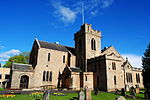Boclair Academy
1978 establishments in ScotlandBearsdenEducational institutions established in 1978EngvarB from February 2019Secondary schools in East Dunbartonshire ... and 1 more
Vague or ambiguous time from March 2021

Boclair Academy, a co-educational comprehensive secondary school located in the Greater Glasgow suburb of Bearsden, East Dunbartonshire, Scotland, serves pupils aged 11 to 18 from Southern Bearsden, Westerton and Torrance. Boclair Academy is affiliated with four local primary schools within its catchment area: Westerton Primary School, Killermont Primary School, Colquhoun Park Primary School and Torrance Primary School. The school's exam achievement has improved in recent years: in 2011 27% of S5 gained at least 5 Higher passes (A-C), ranking Boclair 11th in Scotland for a state school.
Excerpt from the Wikipedia article Boclair Academy (License: CC BY-SA 3.0, Authors, Images).Boclair Academy
Templehill View,
Geographical coordinates (GPS) Address Nearby Places Show on map
Geographical coordinates (GPS)
| Latitude | Longitude |
|---|---|
| N 55.916388888889 ° | E -4.3038888888889 ° |
Address
Templehill View
G61 2QS , Kessington
Scotland, United Kingdom
Open on Google Maps







